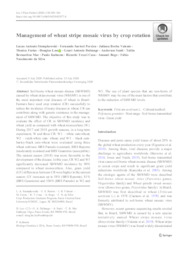Management of wheat stripe mosaic virus by crop rotation.
Management of wheat stripe mosaic virus by crop rotation.
Autoria: STEMPKOWSKI, L. A.; PEREIRA, F. S.; VALENTE, J. B.; FARIAS, M.; LAU, D.; DALMAGO, G. A.; SANTI, A.; MAR, T. B.; KUHNEM, P.; CASA, R. T.; BOGO, A.; SILVA, F. N. da
Resumo: Soil-borne wheat mosaic disease (SBWMD) caused by wheat stripe mosaic virus (WhSMV) is one of the most important viral diseases of wheat in Brazil. Farmers have used crop rotation (CR) successfully to reduce the incidence of many diseases in wheat. CR can contribute along with genetic resistance in the management of SBWMD. The objective of this study was to evaluate the effect of CR in SBWMD incidence and wheat yield as compared with wheat monoculture (W). During 2017 and 2018 growth seasons, in a long-term experiment, W and three CR: W1 ? white oats-wheat; W2 ? vetch-white oats- wheat; and W3 ? black oatsbarley-black oats-wheat were evaluated using three wheat cultivars: BRS Parrudo (resistant), BRS Reponte (moderately resistant) and BRS Guamirim (susceptible). The rainiest season (2018) was more favorable to the development of the disease. In this year, CR W2 and W3 significantly decreased SBWMD incidence by 90% compared to wheat monoculture. Also, grain yield (GY) differences between CR were higher in the rainiest season. GY increases up to 58% (BRS Reponte), 81% (BRS Guamirim) and 106% (BRS Parrudo) in W2 and W3. The use of plant species that are non-hosts of WhSMV may be one of the main factors that contribute to the reduction of SBWMD levels. Keywords Triticum aestivum L. . Cultural method . Polymyxa graminis. Host range . Soil-borne transmitted virus. Grain yield
Ano de publicação: 2020
Tipo de publicação: Artigo de periódico
Unidade: Embrapa Trigo
Palavras-chave: Borne transmitted, Cultural method, Grain yield, Host range, Polymyxa Graminis, S Triticum aestivum L, Soil, Triticum, Vírus
Observações
1 - Por padrão são exibidas publicações dos últimos 20 anos. Para encontrar publicações mais antigas, configure o filtro ano de publicação, colocando o ano a partir do qual você deseja encontrar publicações. O filtro está na coluna da esquerda na busca acima.
2 - Para ler algumas publicações da Embrapa (apenas as que estão em formato ePub), é necessário ter, no celular ou computador, um desses softwares gratuitos. Sistemas Android: Google Play Livros; IOS: iBooks; Windows e Linux: software Calibre.
Acesse outras publicações
Acesse a Base de Dados da Pesquisa Agropecuária (BDPA) para consultar o acervo completo das bibliotecas da Embrapa.

